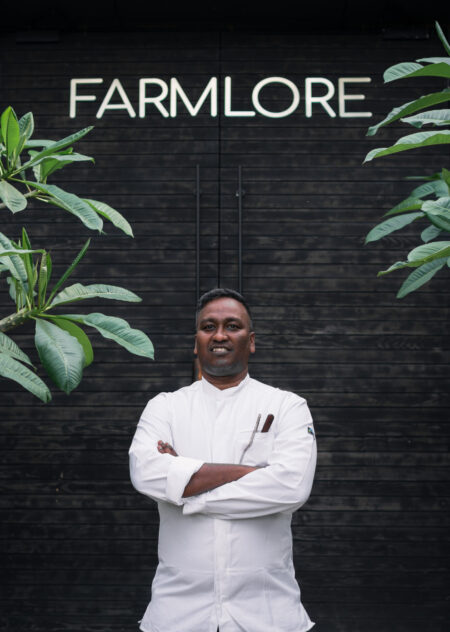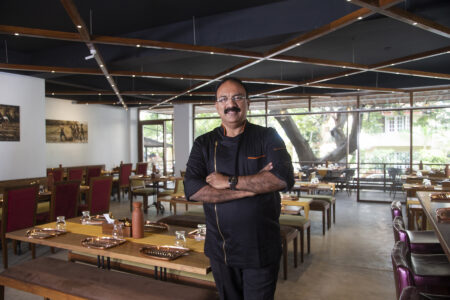The toro carpaccio of 24 hour cured fatty tuna belly, smoked in cherry wood, dressed with white miso, delicately showered with shaved white and black perigord truffles, a dab of flying fish roe on top, is a quick and perfect introduction to the mingling of Japanese and Western flavour profiles and ingredients that is the hallmark of Masaharu Morimoto’s particular style of fusion cuisine. The legacy of Nobu, where Morimoto was Executive Chef, before he launched his eponymous restaurants lingers in dishes such as black-cod miso, Nobu Matsuhisa’s signature dish. However, Morimoto’s own, distinctive brand of fusion, which has influenced an entire generation of young chefs, comes from pursuing traditions and ingredients from Asia, Europe and Latin America, bringing many accents to his cuisine rooted in Japan. Cross-cultural flavour profiles are what you can expect at his restaurants, some 15 of them now spread across the world. In an interesting episode from the early days, a young Indian chef, Vikramjit Roy, part of the new team at the first Wasabi that opened in Mumbai, in 2004, was spotted by the Iron Chef himself, while Roy was serving omakase at a Tokyo restaurant, a rare honour for a non-Japanese chef. Roy was whisked away to the United States to train under Morimoto, and returned to India, setting the benchmark for Wasabi’s chefs, rigorously maintained to date.
In an interesting episode from the early days, a young Indian chef, Vikramjit Roy, part of the new team at the first Wasabi that opened in Mumbai, in 2004, was spotted by the Iron Chef himself, while Roy was serving omakase at a Tokyo restaurant, a rare honour for a non-Japanese chef. Roy was whisked away to the United States to train under Morimoto, and returned to India, setting the benchmark for Wasabi’s chefs, rigorously maintained to date.  Wasabi by Morimoto at the Taj Mahal Hotel, New Delhi is now in its 12th year of presenting fusion Japanese food to a capital city notorious for its fixed tastes (note the immense number of chicken dishes on every menu in the city). Yet, not only is this stylish restaurant —its interiors suggestive of fluid movement, flux and theatre — crowded almost every evening, but alongside the city’s trendy crowd are very young couples and obvious first-time guests, absorbed in avocado tartare over organic baby radish; or Shira-ae: mashed tofu with asparagus, mushroom and water chestnut with garlic-sesame sauce. This speaks much for the service, which is exceptional, at Wasabi, with friendly and efficient servers willing to spend time attending tables, explaining dishes and ingredients, so essential to the enjoyment of a cuisine that is still unfamiliar to many.
Wasabi by Morimoto at the Taj Mahal Hotel, New Delhi is now in its 12th year of presenting fusion Japanese food to a capital city notorious for its fixed tastes (note the immense number of chicken dishes on every menu in the city). Yet, not only is this stylish restaurant —its interiors suggestive of fluid movement, flux and theatre — crowded almost every evening, but alongside the city’s trendy crowd are very young couples and obvious first-time guests, absorbed in avocado tartare over organic baby radish; or Shira-ae: mashed tofu with asparagus, mushroom and water chestnut with garlic-sesame sauce. This speaks much for the service, which is exceptional, at Wasabi, with friendly and efficient servers willing to spend time attending tables, explaining dishes and ingredients, so essential to the enjoyment of a cuisine that is still unfamiliar to many.  If you opt out of the extensive choices of sushi, tempura and teppanyaki on the menu, the very young Chef-in-Charge, Shubham Thakur, will present an impeccable omakase, paired with a fine offering of Sakés that justifies every bit of the substantial cost. It’s essential to view your choices within the framework of premium ingredients in peak season and condition, flown in several times a week from Tsukuji, Tokyo’s iconic market; of flavour highlights not just in Kobe beef and Hokkaido scallops, but the delicate sprigs of kinome (Japanese mint), mitsuba, (Japanese wild parsley) and sansho, (Japanese prickly ash). It offers a perspective on the kind of presentations Wasabi creates.
If you opt out of the extensive choices of sushi, tempura and teppanyaki on the menu, the very young Chef-in-Charge, Shubham Thakur, will present an impeccable omakase, paired with a fine offering of Sakés that justifies every bit of the substantial cost. It’s essential to view your choices within the framework of premium ingredients in peak season and condition, flown in several times a week from Tsukuji, Tokyo’s iconic market; of flavour highlights not just in Kobe beef and Hokkaido scallops, but the delicate sprigs of kinome (Japanese mint), mitsuba, (Japanese wild parsley) and sansho, (Japanese prickly ash). It offers a perspective on the kind of presentations Wasabi creates.  Having dined at Morimoto Napa, and made repeated visits to Morimoto NYC, where the Iron Chef’s particular style of fusion —subtle layering and blending of ingredients and technique —is infused with a new energy, something which can be also be said of Wasabi, I would pass over the now too-familiar black-cod miso, or rock lobster tempura with wasabi mayonnaise, choosing instead some of the dishes which have been created by Executive Chef Arun Sundararaj and his team. Worth exploring is the use of local sea food, sourced from collaborations with fishmongers in southern India to create select hot dishes. Choices from my dinners here would include baked eel; scallop roses —razor thin slices of Hokkaido scallops, marinated with ginger, chopped mitsuba, salted kelp, brushed with a soy onion dressing, arranged into roses and tempered with sesame oil; the umami laden tatami iwashi, a sheet of dried baby sardines, and matcha flavoured ice cream over coconut cookie crumbs. Wasabi manages to break, in the most agreeable way, all the stereotypes about the cuisines that are attracting a dedicated following in urban India.
Having dined at Morimoto Napa, and made repeated visits to Morimoto NYC, where the Iron Chef’s particular style of fusion —subtle layering and blending of ingredients and technique —is infused with a new energy, something which can be also be said of Wasabi, I would pass over the now too-familiar black-cod miso, or rock lobster tempura with wasabi mayonnaise, choosing instead some of the dishes which have been created by Executive Chef Arun Sundararaj and his team. Worth exploring is the use of local sea food, sourced from collaborations with fishmongers in southern India to create select hot dishes. Choices from my dinners here would include baked eel; scallop roses —razor thin slices of Hokkaido scallops, marinated with ginger, chopped mitsuba, salted kelp, brushed with a soy onion dressing, arranged into roses and tempered with sesame oil; the umami laden tatami iwashi, a sheet of dried baby sardines, and matcha flavoured ice cream over coconut cookie crumbs. Wasabi manages to break, in the most agreeable way, all the stereotypes about the cuisines that are attracting a dedicated following in urban India. 
Sake Selections at Wasabi:
Masumi Sanka Junmai Daiginjo
Kiku Masamune Taru Sake
Asabiraki Honjozo Namachozo
Masumi Kippuku Kinju Sake
Masumi Tokusen
By: Kaveri Ponnapa
Images Courtesy: Taj Mahal Hotel, New Delhi
This article appeared in Sommelier India Magazine Volume 15, Issue 2, Summer 2109




